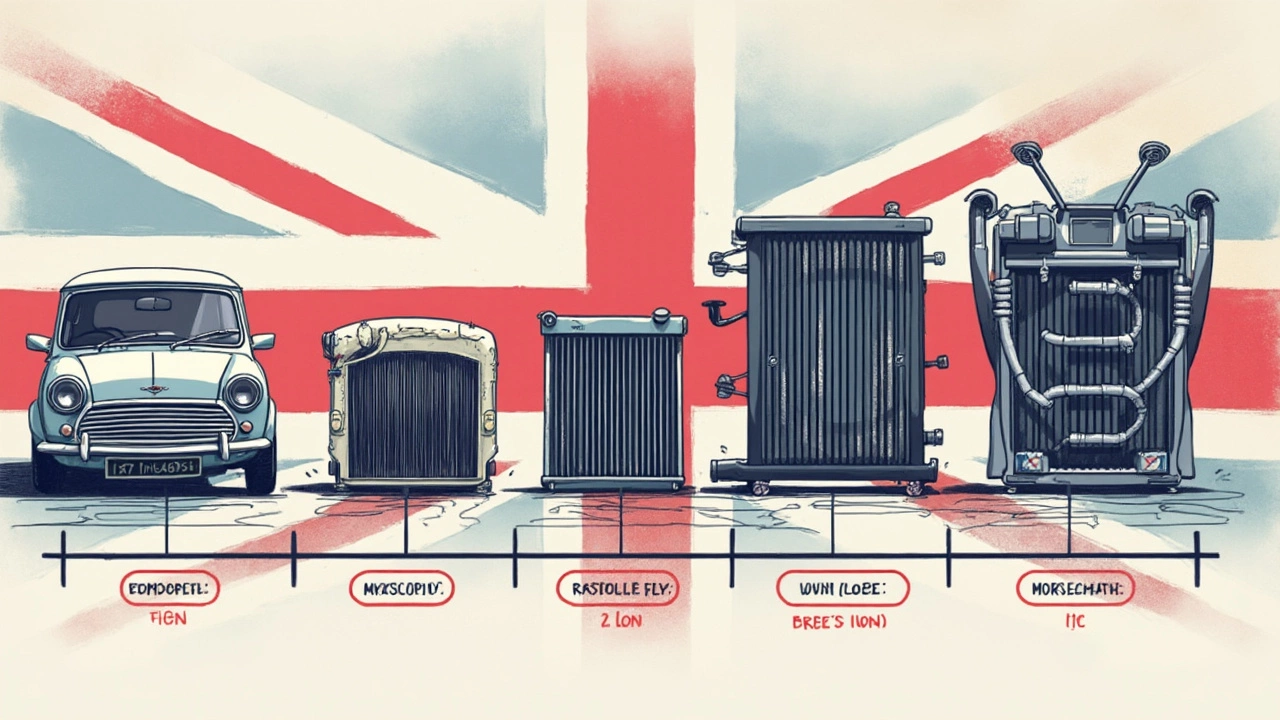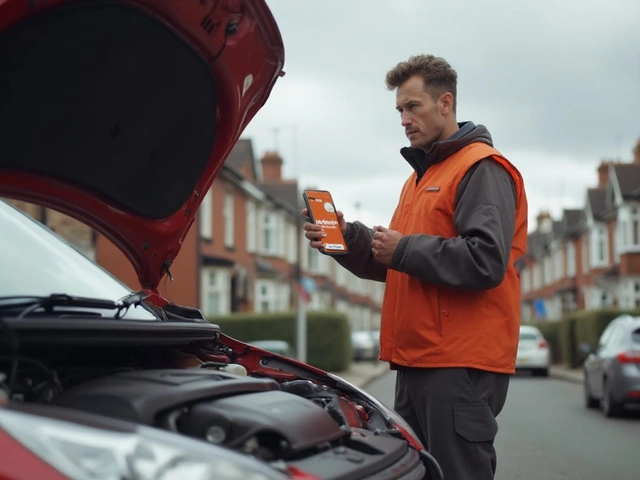Ever pop your hood and wonder what that big metal part up front does? That’s your car radiator—arguably the unsung hero under the hood. It keeps your engine from turning into an expensive hunk of useless metal, all by handling one job: dumping heat. If your radiator checks out on its job, your engine stays cool. If it quits, you’re looking at steam, breakdowns, maybe even a huge repair bill.
Knowing what a radiator does isn’t just for mechanics. Spotting signs of trouble early can save you thousands (and a lot of hassle). Whether you notice weird temperature spikes on your dash or puddles showing up under your car, those are your clues. A healthy radiator is the difference between a smooth drive and roadside misery, so it’s worth learning the basics.
- What Exactly Is a Car Radiator?
- How Does the Radiator Keep the Engine Cool?
- Common Reasons Radiators Fail
- How to Spot and Prevent Radiator Problems
- Radiators: Then vs. Now
What Exactly Is a Car Radiator?
Think of the car radiator as the main component of your vehicle’s cooling system. Its job? Take the super-hot coolant from your engine, dump the heat, and send that cooler fluid back in a constant loop. This keeps your engine running at a good temperature, so things don’t get fried. Without a functioning radiator, your engine would overheat in just minutes, especially during summer traffic or when you’re hauling heavy loads.
A radiator looks kind of like a metal box with a bunch of thin pipes and fins. When hot coolant comes in from the engine, it passes through these thin tubes. Air from outside your car blows over the fins—either from driving or with help from a fan—cooling down the fluid inside. Then the coolant cycles back to the engine to repeat the process. It’s simple, but super effective.
Most radiators are made from aluminum these days, since it’s light and transfers heat well. Older models might be brass or copper, which work too, but aren’t as light or efficient. No matter the metal, the basic idea hasn’t changed much in decades.
| Material | Heat Transfer Efficiency | Common Use |
|---|---|---|
| Aluminum | High | Modern cars |
| Copper/Brass | Very High | Classic cars, heavy-duty vehicles |
| Plastic (on ends) | Low (but lightweight) | Mixed with metal cores |
The car radiator connects to the rest of the cooling system by rubber hoses. You’ll usually see a radiator cap right on top or off to the side. That cap’s not just to look shiny—it holds pressure in the system so coolant doesn’t boil over too soon. Some radiators even have built-in sensors to alert you if things get too hot or you’re low on coolant. Simple, but genius engineering keeps your engine from giving up on you.
How Does the Radiator Keep the Engine Cool?
The radiator is basically a giant heat exchange station for your car. Your engine burns fuel, which means it gets hot—sometimes up to 200°F (93°C) or even more. If that heat hangs around, metals start to warp, gaskets fail, and the whole thing can lock up. The radiator steps in to keep things under control.
Here’s the basic play-by-play:
- Your engine heats up. Coolant (think of it as high-tech antifreeze mixed with water) loops through the engine, soaking up all that heat.
- That hot coolant shoots toward the front of your car and runs into the radiator. The radiator has tons of thin metal tubes and fins—lots of surface area for heat to escape.
- As the car moves, air rushes through the radiator’s fins and cools down the hot coolant inside.
- A fan kicks on at slower speeds or when you’re idling. It blows air over the radiator to keep things cool when you’re stuck in traffic.
- Now-chilled coolant heads back to the engine to grab more heat. The cycle keeps repeating every time you drive.
Here’s a quick look at why this matters:
| What If the Radiator Fails? | What Happens |
|---|---|
| Coolant Overheats | Engine can overheat in as little as 15 minutes—damage gets expensive, fast. |
| Leaks or Blocked Fins | Coolant can’t dump heat, so temp goes up and warning lights kick on. |
| Faulty Fan | Car might stay cool on the highway but overheats in traffic. |
The car radiator isn’t just a chunk of metal. It’s carefully made, and even a tiny leak can mess up your whole system. If your temp gauge ever spikes or you notice your heater isn’t working when it’s cold outside, those are big red flags. Don’t ignore them—fixing a tiny radiator problem beats replacing an engine any day.

Common Reasons Radiators Fail
The radiator in your car might seem tough, but a lot can go wrong and it’s usually not subtle. The most common culprit is a leak. These usually show up as coolant puddles under your vehicle, which is never a good sign. Leaks often come from worn hoses, cracked plastic tanks, or even pinholes in the metal itself.
Another big issue is corrosion. Modern radiators aren’t solid iron anymore, but they still rust from the inside out if old coolant or plain tap water is used. Corrosion eats away at the radiator’s metal, causing tiny holes and blockages. Speaking of blockages, sludge and scale build-up inside the tubes is a classic reason for a radiator to quit working. This kind of gunk can come from not changing coolant on time or using the wrong type of fluid completely.
Don’t forget the radiator cap. If that little part stops holding pressure right, the whole system can overheat or boil over, even if everything else is perfect. Sometimes, folks ignore a bad cap because it seems harmless, but it can easily lead to a serious engine mess.
- Leaking coolant due to worn hoses, seals, or cracks
- Rust and corrosion from old or improper coolant
- Blockages or sludge inside the radiator’s tubes
- Faulty radiator cap that fails to keep proper pressure
- Damage from stones or road debris hitting the unit
Older cars often get hit harder by these issues since parts wear out and they might use outdated radiator technology. Catching early warning signs—like temperature gauge spikes or a low coolant level—can stop a simple fix from turning into blown engine drama. If you want your car radiator to last, keep an eye out for these problems and stay on top of basic maintenance.
How to Spot and Prevent Radiator Problems
If your car radiator goes bad, you’re stuck. That’s why catching issues early can save you tons of trouble and cash. Look for these telltale signs:
- Rising engine temperature: If your temp gauge creeps into the red, your radiator could be clogged or leaking.
- Puddles under your car: Green, orange, or even pinkish fluid means coolant is leaking. That's a big warning sign your radiator or hoses have a problem.
- Rusty or gunky coolant: Pop off the radiator cap (when the engine's cool) and check. Healthy coolant looks clean. Gunk or rust means trouble inside the radiator.
- Strange noises: Bubbling, hissing, or steam from under the hood is often a sign your radiator can’t keep up.
Here’s a wild stat: Over 40% of engine failures are connected to cooling system issues, not the engine itself. That’s a lot of avoidable pain from something as small as a crack in your radiator or old, worn hoses.
| Radiator Problem | What You’ll Notice | Best Next Step |
|---|---|---|
| Leaking Coolant | Puddles, low coolant, wet spots | Find leak, replace or hose or radiator, top off coolant |
| Clogged Radiator | Engine overheating, heater not working | Flush system, replace with clean coolant |
| Damaged Fins | Overheating, visible bent fins on the radiator | Straighten fins gently, or replace if corrosion is deep |
| Loose or Broken Cap | Coolant boils over, leaks at cap | Replace with factory-approved cap |
Preventing radiator headaches is about staying ahead. Regular maintenance is a lifesaver:
- Check coolant levels at least once a month. Top off if it’s low, always using the type shown in your owner’s manual.
- Inspect hoses and clamps for cracks, bulges, or leaks. Most pros recommend giving these a look every oil change.
- Flush the radiator every 2 years, or as your manual suggests. Old coolant turns acidic and eats up parts from inside out.
- Keep an eye on the temp gauge – if it acts weird, something’s off. Don’t ignore it.
And don’t panic about the details. As
"Ignoring your radiator is like skipping dentist appointments—everything seems fine until it isn’t. Regular checks make all the difference.” — Jim Moylan, ASE Master TechnicianLittle steps with your radiator keep your engine happy and your drives worry-free.

Radiators: Then vs. Now
Old-school car radiators were nothing like what you see on most cars today. If you drove a classic ride from before the 1980s, your radiator was probably made of copper and brass. These metals handled heat well but were pretty heavy and cost more to make. They needed a lot of maintenance—leaks, corrosion, and clogs happened all the time. If you messed up and used the wrong coolant, that radiator would let you know by springing a leak ASAP.
Modern radiators flip the script. Most new cars use aluminum radiators with plastic end tanks. This combo cuts weight, boosts fuel economy, and is way cheaper to build at scale. Still, some performance cars opt for all-aluminum because it lasts longer and cools better under stress. Today's radiators are more efficient and reliable, but when plastic parts fail (which they eventually do), you usually have to replace the whole unit instead of just fixing a corner.
Check out this quick comparison of main changes from 'then' to 'now':
| Era | Main Materials | Common Issues | Average Lifespan |
|---|---|---|---|
| Classic (pre-1980s) | Copper/Brass | Leaking, corrosion, weight | 5-8 years |
| Modern (1990s-now) | Aluminum/Plastic | Plastic cracks, full replacements | 8-12 years |
Here’s the kicker: while old radiators required more hands-on fixes, today’s setups are more of a "use it till it dies" story, unless you drive something special. Plus, with better car radiator technology, you can pick up extra horsepower and improved cooling just by swapping out to a high-performance unit. So, whether your car is a daily commuter or a weekend project, knowing how things have changed helps you make smarter choices when it’s time for a radiator repair or upgrade.






